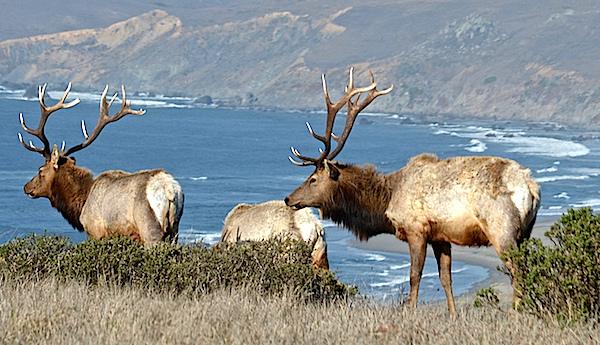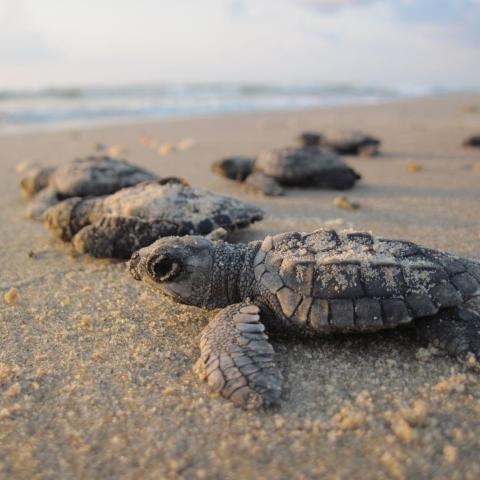
The population of one herd of Tule elk at Point Reyes National Seashore has declined precipitously, drawing charges of mismanagement/David McSpadden via flickr
Charges of wildlife mismanagement by the staff at Point Reyes National Seashore are being leveled in the wake of the deaths of more than 200 Tule elk caused, apparently, by a lack of water inside their fenced preserve.
While park biologists point to California's long-running drought as a primary cause for the deaths of more than 250 elk between 2012 and 2014, staff at the Center for Biological Diversity note that elk at the seashore that are not penned in have been enjoying a population boom of sorts.
"Tule elk need room to roam, and native wildlife in our national park should not be fenced in or prevented from finding water and food," said Jeff Miller with the Center. "The loss of nearly half the Pierce Point elk herd highlights how important it is that the Park Service not cave to commercial ranchers who want free-roaming Point Reyes elk fenced in."
Point Reyes is just the latest National Park System unit enmeshed in wildlife issues spurred by a lack of space. At Yellowstone National Park the plight of bison, which are killed by the hundreds each year when they roam out of the park and into Montana, has been well-documented. At Cape Hatteras National Seashore in North Carolina the Park Service has been castigated for fencing off large areas of beach to allow for nesting piping plovers, a threatened species. Culling operations for elk and deer have been used at Rocky Mountain National Park in Colorado, Wind Cave National Park in South Dakota, Cuyahoga Valley National Park in Ohio, and Valley Forge National Historical Park in Pennsylvania, just to cite a few examples.
Dave Press, a wildlife ecologist at Point Reyes, said Friday afternoon that the ongoing drought that has gripped California for four years now contributed greatly to the die-off of the herd that lives within a 2,600-acre fenced-in preserve on Tomales Point.
"Considering we are in one of the worst droughts in Californial history, it doesn't surprise us that there were impacts to the Tule elk up at Tomales Point," he said. "I think the presence of the fence contributed to the severity of those impacts. The free-range elk, just by the nature of where they occur, they are associated with areas that have year-round water supplies. Creeks that flow year-round, ponds.'
The preserve was created in 1978 when an elk recovery program brought 10 animals to Tomales Point, explained the wildlife ecologist.
"We didn't want to put 10 elk out there and then just have those elk go their separate ways, not breed, not establish and create a robust herd," said Mr. Press.
Concerns that Tule elk might overlap with cattle on the point spurred the decision to keep the herd fenced in, he added.
Now, however, the die-off likely will fan controversy as the Park Service develops a ranch management plan for the national seashore. There are, Mr. Press said, about 22 ranching operations on the national seashore and neighboring Golden Gate National Recreation Area. While the ranches are on Park Service land, they existed before the national seashore was created.
"Part of the main reason the park is here was because of that partnership that was reached between the conservationists and ranching interests," the ecologist explained.
When former-Interior Secretary Ken Salazar visited Point Reyes in 2012 to look into the propriety of an oyster farm operating in the seashore on land tagged to become wilderness, he issued a memorandum authorizing the Park Service to pursue long-term lease/permits for dairy and beef ranching operations that operate on roughly 28,000 acres of the national seashore.
Now the Center for Biological Diversity, against the backdrop of the elk die-off, is criticizing the planning effort.
Cattle ranchers who enjoy heavily subsidized cattle grazing leases on public lands within the national seashore are lobbying the Park Service to remove or fence out the free-roaming elk from ranching areas, because elk are eating grass they believe should be reserved solely for their cattle. The Park Service is considering evicting the free-roaming elk under a planning process initiated for 28,000 acres of leased dairy and beef cattle ranches within the park and Golden Gate National Recreation Area lands in Marin County administered by the national seashore. The Park Service is also proposing extending ranching leases for up to 20 years, and may allow ranchers to expand their operations to animals other than cattle, which would create more conflicts between livestock and native wildlife.
At the national seashore, Mr. Press said a number of alternatives are being discussed. While some call for more fencing of elk, or fencing-out of cattle pastures, others identify culling as one action. A draft plan for public review is expected late this year, he said.
Tule elk are native and endemic to California. There were once 500,000 tule elk in the state but by the late 1800s impacts from cattle ranching and hunting had reduced them to only 28 elk, according to a release from the Center for Biological Diversity. From one surviving herd, Tule elk were reintroduced throughout the state and there are now 4,300 elk in 25 herds. Tule elk were returned to Pierce Point at Point Reyes in 1978, and a free-ranging herd was established in the park in 1998. Point Reyes Seashore is the only national park with tule elk.
According to the Center, the Pierce Point herd declined from 540 elk in fall of 2012 to 286 elk by 2014, a drop of 47 percent. There are no natural year-round fresh water sources on Pierce Point and the elk in the preserve are prevented from migrating by a large, elk-proof fence, the organization adds. During the same drought period, the free-roaming Point Reyes elk herds 'which had access to water ' increased by 32 percent. The Limantour herd grew from 94 to 120 elk and the Drakes Beach herd increased from 66 to 92 elk.
"The reintroduction of elk to the Point Reyes peninsula is a success story for conservation of native species, but the elk are in jeopardy of eviction to benefit a few lease holders," said Mr. Miller. "The Park Service already prioritizes commercial cattle grazing in Point Reyes. Now these subsidized ranchers want to dictate park policies that could eliminate native elk and harm predators and other wildlife."
According to the Center, "(T)here are 13 cows for every elk in the national seashore, with nearly 6,500 dairy and beef cattle and only 498 elk. One-quarter of the national seashore is devoted to commercial cattle operations, with grazing on nearly 18,000 acres under 39 leases. Ten ranching families were paid $19.6 million by the public from 1963 to 1978 for the purchase of ranch lands added to Point Reyes National Seashore. Many of those same families still enjoy heavily subsidized grazing lease rates within the park, paying one-half to one-third the cost they would pay for non-federal grazing land in Marin."




 Support Essential Coverage of Essential Places
Support Essential Coverage of Essential Places







Comments
It is a symbolic fence intended to keep people from disturbing unique to CHNS nesting birds, as specficed in that Park's EL.
"and no development of the project or plan for the convenience of visitors shall be undertaken which would be incompatible with the preservation of the unique flora and fauna"
I don't think it really matters much that AMOYs are not a listed species. I thought Kurt's intention was just relating similar instances not implying that wild birds were being fenced in a national park.
Ecbuck,
It is to bad those sponsors didnt make their intentions clear when they sponsored the bill. Because the bill's language is much more clear that the area was suppose to become Wilderness area with no oyster farm. And then there is the lease that was signed. What would you do with a tenant that signed a lease to leave and you had different plans for your property that you intended to pursue.
It is why these things are written and not done with a handshake and a promise.
Show me the language that said the oyster farm had to leave so that the area could become Wilderness.
Tenants don't sign leases "to leave". I have several lease tenants and it is my hope and expectation and theirs that when the lease expires we will negotiate another one to keep them in place.
Unique? These birds are found all over VA and NC coastal regions.
Beachdumb,
They are unque to the specialized habitat and phisiographic properties of the Seashore. The word unique has meaning in the EL or it would not be there. By your definition nothing would be unique. In addition NC has these birds listed as species of concern. It is not up to the state of NC to dictate how federal mangers manage resources in a National Park (Seashore) which are consistently held to a higher standard than other federal land. It is enough that NC has identified AMOYs has having issues, maybe the state should take a lesson from how the Feds are managing these birds and if succesful they could be removed from the state's list.
Or maybe the Feds should take a lesson from the State since they manage and have more experience with these populations then the Feds do. So you agree that the AMOYS are not unique to the Seashore.
AMOYs are most definItely part of CHNS unque fauna.
I ask again Buxton - can you share that language with us?